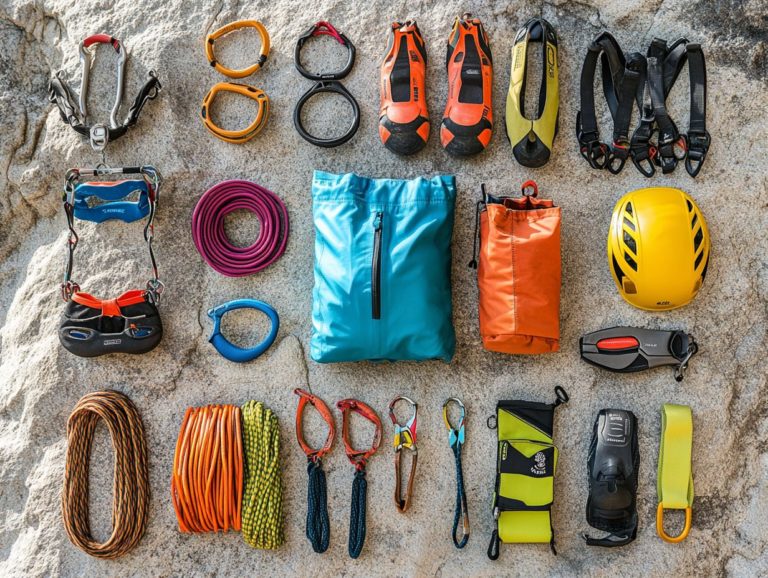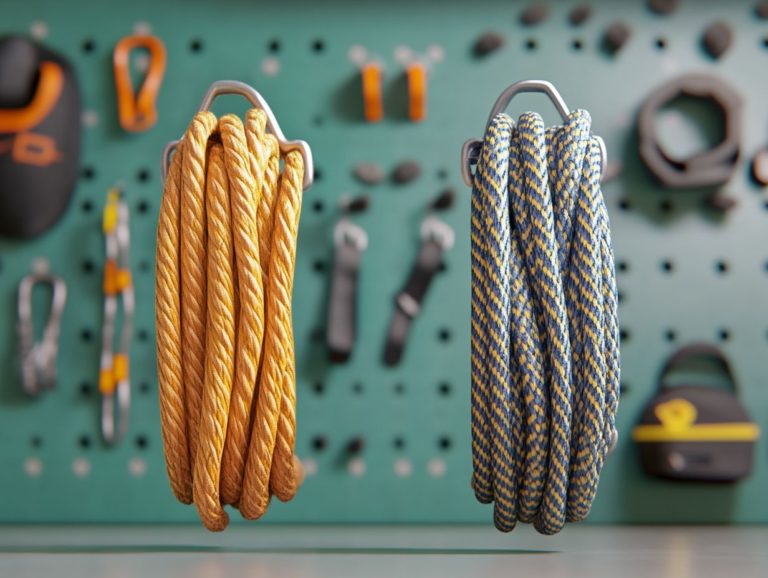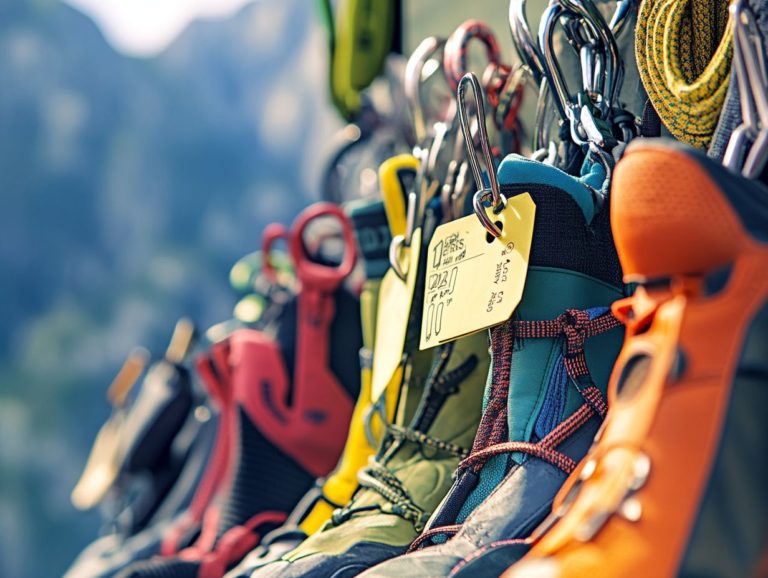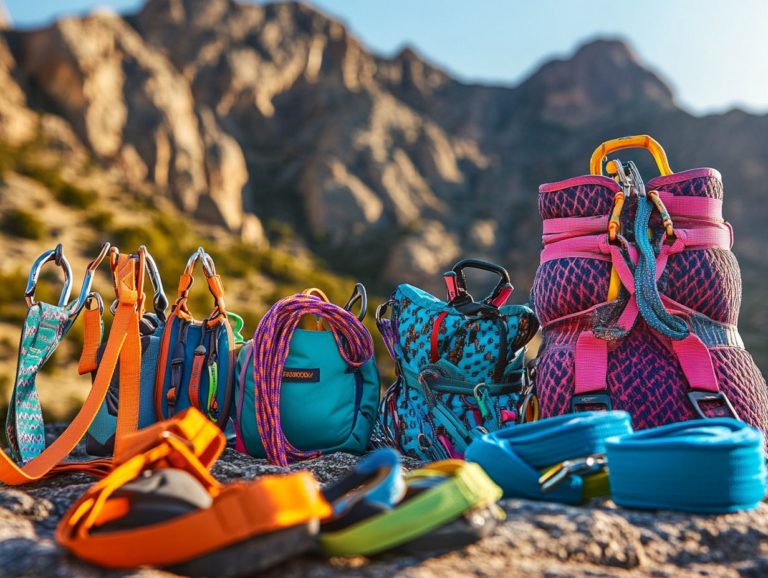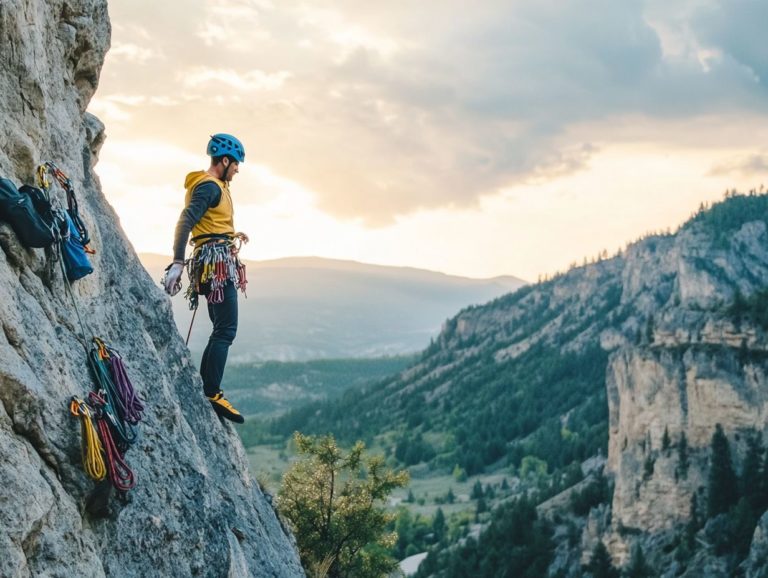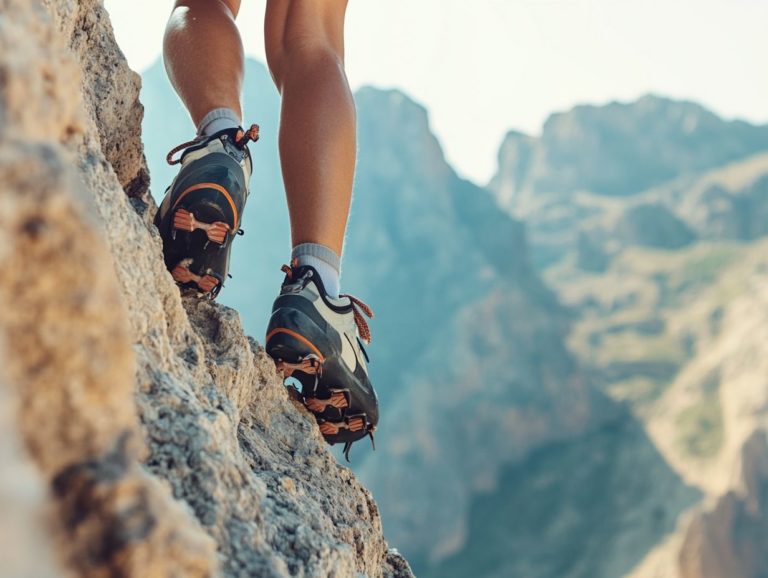What to Know About Climbing Gear Weights
Understanding the weights of climbing gear is vital for both novice and experienced climbers. These weights significantly influence safety, performance, and the overall climbing experience.
The weights of different pieces of equipment ranging from climbing ropes to harnesses are shaped by the materials used and their construction. This is closely tied to their strength ratings, average breaking strength, and kilonewtons, a unit that measures strength.
The working load limit is crucial for determining how much weight each piece of gear can support reliably in different climbing conditions. Grasping these elements thoroughly is vital for ensuring optimal performance across a variety of climbing situations.
Contents
- Types of Climbing Gear and Their Weights
- Key Takeaways:
- Factors Affecting Climbing Gear Weights
- Size and Functionality
- Brand and Price
- Choosing the Right Gear for Your Needs
- Frequently Asked Questions
- What to Know About Climbing Gear Weights?
- 1. How important is it to consider the weight of my climbing gear?
- 2. What factors should I consider when looking at the weight of my climbing gear?
- 3. How can I determine if a piece of gear is too heavy for me?
- 4. Are there specific types of climbing gear that tend to be heavier than others?
- 5. How can I reduce the weight of my climbing gear without compromising safety?
- 6. Is it worth investing in lightweight gear for climbing?
What is Considered Climbing Gear?
Climbing gear refers to the essential equipment and accessories that ensure your safety and enhance your performance during rock climbing adventures. This includes must-have items like climbing harnesses, climbing shoes, belay devices, climbing ropes, quickdraws, climbing protection, and helmets. As a beginner climber, grasping what constitutes climbing gear is vital, as it directly impacts your overall climbing experience and safety on the crag.
Each piece of gear plays a distinct role. For instance, climbing harnesses secure you while allowing for freedom of movement, with high-quality brands like La Sportiva offering an exceptional fit and comfort. Climbing shoes are crucial for providing grip and sensitivity on various surfaces, significantly influencing your performance.
Belay devices, often from trusted companies like Petzl, help you control rope tension during ascents and descents, adding an extra layer of safety. Climbing ropes are your lifeline, protecting you during falls, while quickdraws simplify the process of attaching the rope to anchors. And let s not overlook helmets; they are essential for head protection, safeguarding you from potential rockfall or dropped equipment.
Choosing quality gear isn t just a matter of preference; it s a necessity for ensuring a safe and effective climbing experience.
Types of Climbing Gear and Their Weights
The different types of climbing gear and their respective weights play a crucial role in shaping your climbing experience, particularly as you explore various styles like crag climbing and technical climbing.
Each item climbing ropes, harnesses, shoes, belay devices, quickdraws, and helmets comes with its own weight specifications, which can greatly influence your climbing performance and safety on the rock face.
By understanding these weights and their practical implications, you enable yourself to make informed decisions about the gear you choose to carry, especially when it comes to working load limits and average breaking strength, ensuring enhanced belayer safety.
Key Takeaways:
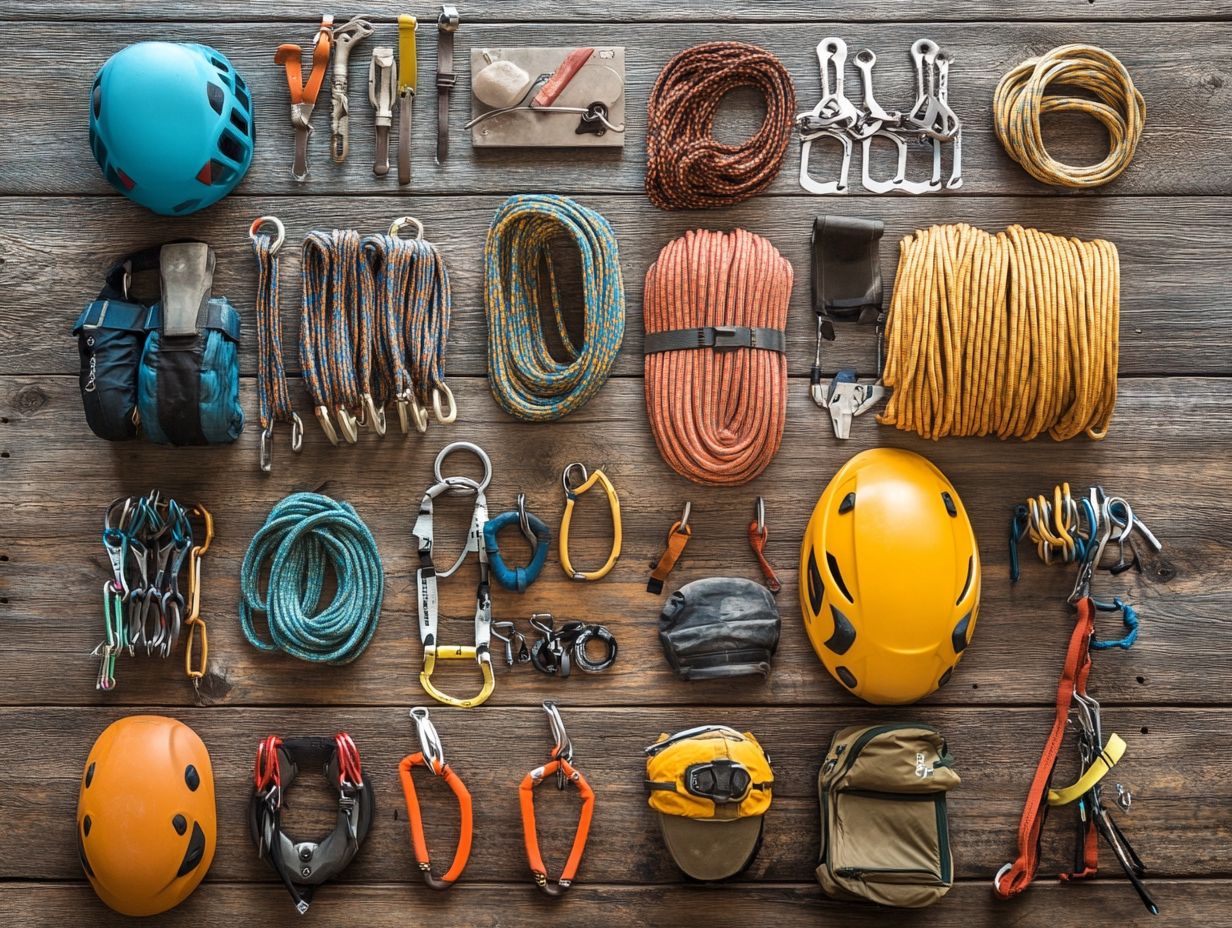
- Climbing gear weight is an important factor to consider when choosing your equipment.
- The type of gear and its materials significantly impact its weight, including strength ratings that ensure safety during your climb.
- Find a balance between weight and performance, considering the working load limit of each item.
Ropes and Harnesses
Climbing ropes and climbing harnesses are absolutely critical to your climbing gear. Their weights are influenced by the materials you choose and the design you opt for, including harness fit.
The average breaking strength of ropes can vary widely. Knowing the working load limit of your harness ensures that you can safely engage in everything from beginner ascents to advanced technical climbs. These elements bolster your safety and significantly enhance your climbing performance during challenging ascents.
For example, dynamic ropes stretch under load, making them perfect for rock climbing. In contrast, static ropes, which tend to be heavier, are reserved for activities like caving and rescue operations, where minimal stretch is essential.
Harnesses are often constructed from durable nylon or polyester, with lightweight designs tailored for sport climbing. These designs prioritize comfort and mobility. If you’re venturing into mountaineering, more robust options are available to meet those demands.
Safety ratings differ across products, guiding you toward choices that align perfectly with your specific needs. By understanding the average breaking strength of your equipment and adhering to the recommended working load limits, you elevate your safety and enhance your overall climbing experience.
Climbing Shoes and Chalk Bags
Climbing shoes are critical for maximizing grip and performance on the rock. Their weights vary significantly based on design, material, and intended climbing style.
You have a range of options, from aggressive shoes that offer precision to neutral ones that provide comfort for extended climbs. Each type has unique advantages.
When choosing climbing shoes, consider how variations in weight and design impact your ability to execute specific maneuvers. The choice between aggressive shoes and neutral shoes is important.
Lighter shoes enhance agility, allowing for quick foot placements. On the other hand, heavier models often provide greater support, which can be beneficial for technical climbs.
The chalk bag is an essential accessory that keeps your hands dry and your grip strong. A well-designed chalk bag should be easily accessible and compact, allowing you to focus on your ascent without unnecessary interruptions. This attention to detail can elevate your overall climbing experience.
Carabiners and Quickdraws
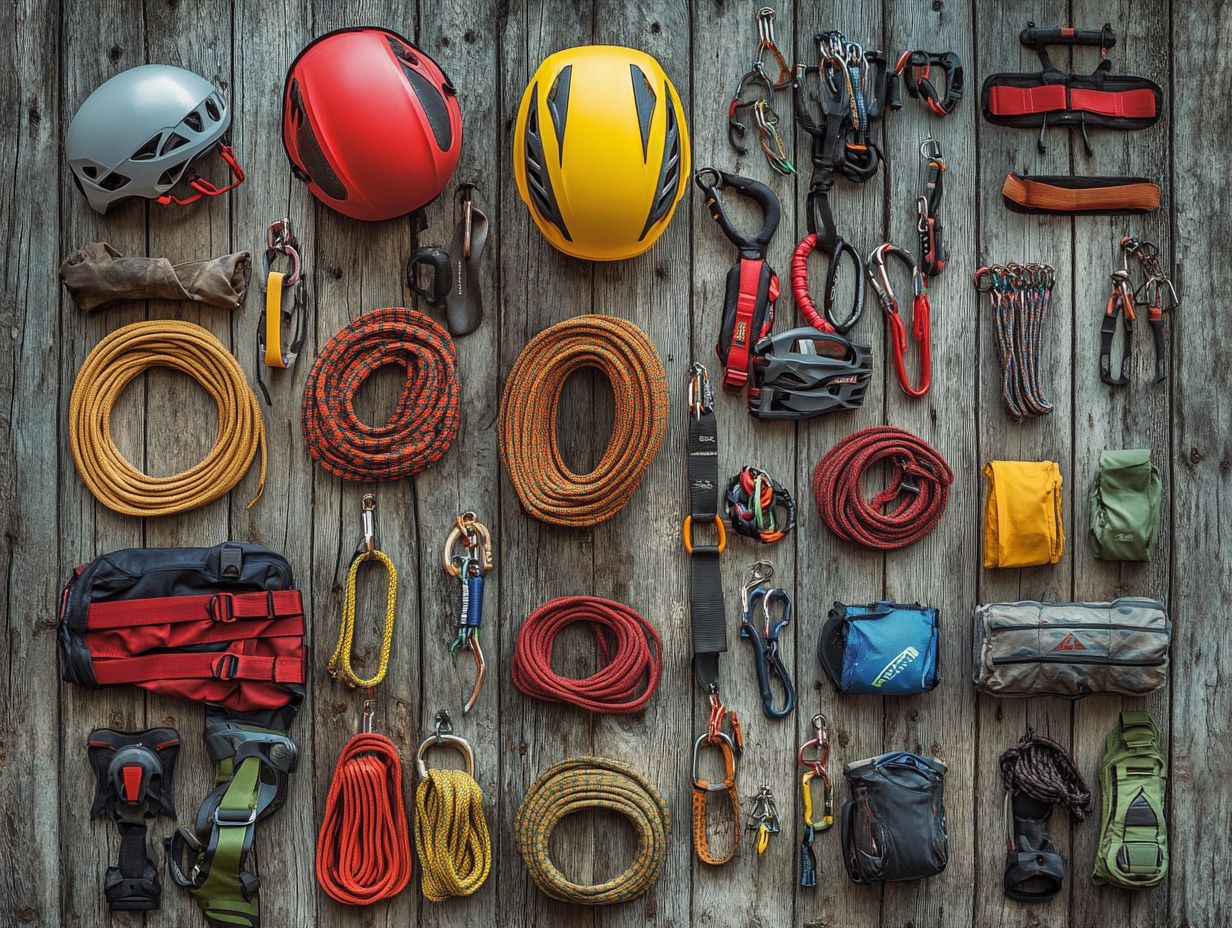
Quickdraws and carabiners are essential elements of your climbing gear, playing a crucial role in ensuring both safety and efficiency during ascents. Their weights can vary significantly, with materials and designs directly influencing their strength and usability.
When used correctly, these tools enhance your safety as a belayer and are critical for securing climbing ropes, providing protection on a variety of routes.
You ll encounter different types of quickdraws, including sport, alpine, and wire-gate. Each type is tailored for specific purposes, affecting their weight and strength, which impacts your overall climbing safety.
For example, lightweight aluminum quickdraws are highly sought after for sport climbing due to their minimal bulk. Conversely, heavier-duty options, like steel quickdraws, offer added security in more demanding conditions.
Carabiners come in a range of shapes and locking mechanisms, impacting their ease of use and reliability. When choosing your gear, consider the specific conditions you ll face along with your personal climbing style. This approach allows you to strike the perfect balance between weight savings and safety requirements to optimize your performance.
Climbing Helmets
Climbing helmets are essential for your safety. They protect you from falling debris and impacts. The weight of your helmet significantly affects your endurance during long ascents, which is why lightweight options are becoming increasingly favored by modern climbers. Ensuring a proper fit is about more than just comfort; it maximizes your protection as you scale new heights.
Different types of climbing helmets cater to various climbing styles, from sport climbing to alpine pursuits. These helmets are graded according to safety ratings that adhere to industry standards, so you can trust your gear when it matters most.
A well-fitted helmet enhances your safety and reduces the risk of discomfort, which can easily become a distraction during challenging climbs. The choice of materials in your helmet s construction plays a crucial role in its weight and durability, directly impacting your performance on the rock.
Choosing the right helmet is crucial for your safety and climbing success as you tackle the challenges of the rock face.
Belay Devices and Anchors
Belay devices and anchors are critical tools in your climbing toolkit, providing safety and control as you ascend and descend. The weight and design of these devices can significantly influence your climbing performance, making it crucial for you to understand their maximum weight limits and how they fit into the overall climbing system, enhancing belayer safety.
By mastering the proper use of belay devices and effective anchor placements, you can greatly enhance your safety as a belayer and increase your chances of climbing success.
In the vast array of climbing gear, you’ll encounter various types of belay devices tube-style, assisted-braking, and figure-eight models each offering unique advantages tailored to different climbing styles. Understanding the safety ratings of anchors is essential, as they can dictate the integrity of your entire system. The material composition, whether aluminum or steel, also plays a pivotal role in weight considerations.
Diving into these nuances enables you to make informed choices, ensuring that your combination of belay devices and anchors conserves your energy during climbs while adhering to safety protocols, ultimately enhancing your overall climbing experience.
Factors Affecting Climbing Gear Weights
Many factors influence the weights of climbing gear, significantly impacting your performance during climbs. The materials and construction are crucial elements that determine the overall weight of your equipment.
Choosing lightweight gear can enhance your mobility and minimize fatigue on challenging ascents. Understanding how different materials affect the durability and strength of each piece of gear is vital for climbers seeking to optimize every aspect of their climbing experience.
Material and Construction
The materials and construction of your climbing equipment play a crucial role in its weight, durability, and performance. Choosing high-quality materials like nylon, polyester, and carbon fiber is essential for ensuring the necessary strength for safety without adding unnecessary bulk.
For example, nylon is stretchy and strong, perfect for dynamic climbing ropes. However, it absorbs water, which can add weight when it gets wet.
On the other hand, polyester is less stretchy but offers excellent UV resistance, making it ideal for slings and webbing. Then there s carbon fiber lightweight and incredibly strong but it often comes with a steep price, which could be a consideration depending on your budget.
By integrating these materials with advanced construction methods, like seamless bonding or reinforced stitching, you enhance performance while minimizing wear and tear. This way, you can trust that your gear will hold up in the most challenging environments.
Size and Functionality
The size and functionality of your climbing gear impact its weight. This, in turn, affects your performance.
Each piece of equipment is crafted with specific functions in mind. Therefore, it’s essential to understand how size influences usability and effectiveness.
Proper gear recommendations consider both the size and intended use of the equipment. This ensures you achieve optimal performance and safety in various climbing scenarios.
Choosing the right size gear boosts your comfort and transforms your climbing experience. For example, when you re in a harness, it s vital that it fits snugly to prevent slippage while allowing the necessary flexibility for movement.
Likewise, the size of your climbing shoes greatly affects your grip and precision as you navigate tricky footholds.
When considering options like carabiners and quickdraws, the fit and weight become paramount. Lighter models may be ideal for alpine ascents, while sturdier sizes are optimal for sport climbs.
In essence, precision in sizing translates directly into improved safety and performance on the rock face.
Brand and Price
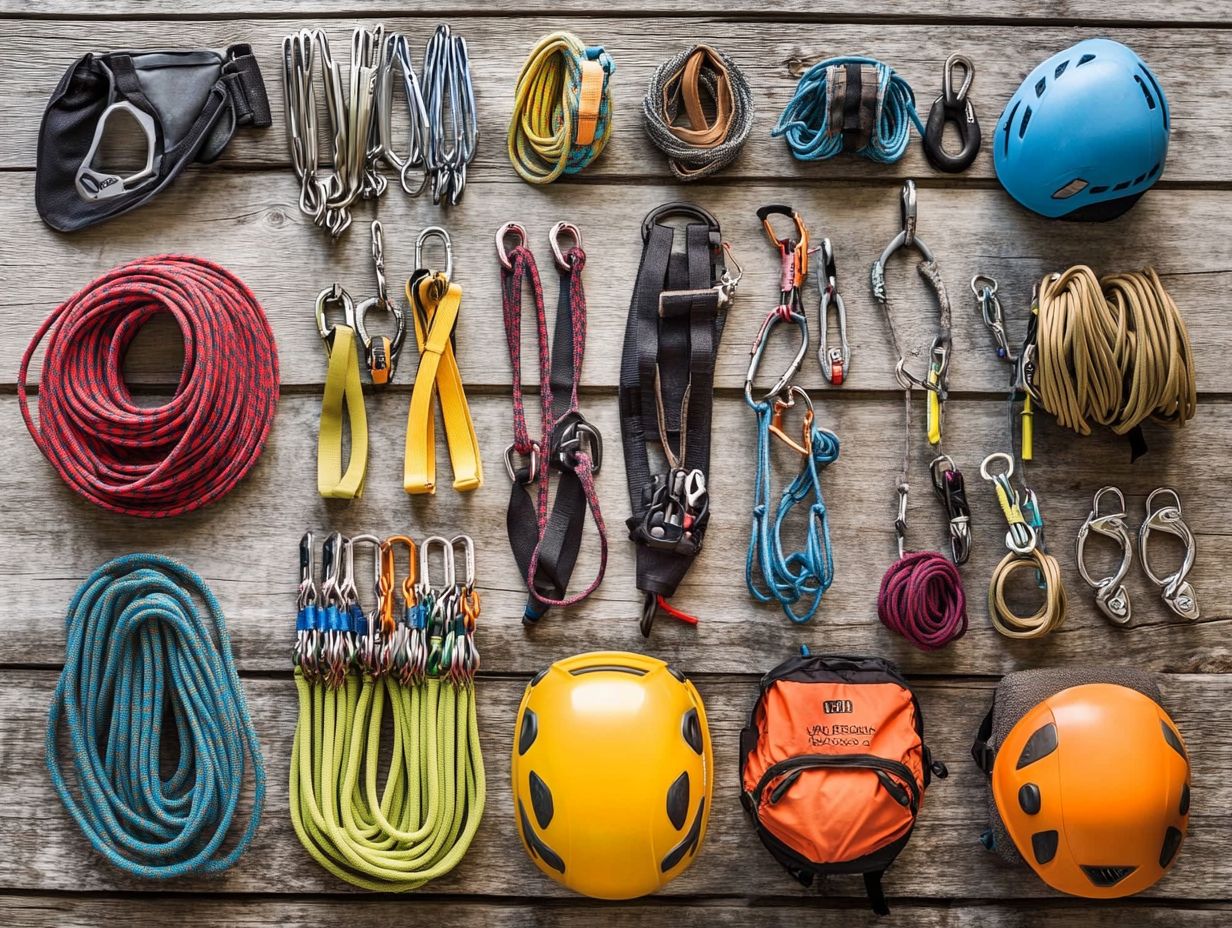
The brand and price of climbing gear significantly shape your choices and overall experience as a climber.
Renowned brands like Black Diamond, Edelrid, La Sportiva, Petzl, Maxim, and Mammut offer a diverse array of equipment, each with varying price points and performance levels.
As a beginner, grasping the connection between brand reputation, price, and quality is crucial for making informed purchasing decisions.
The reliability of these brands often translates into enhanced safety features and improved durability, essential in high-stakes environments.
For instance, an experienced athlete may prioritize performance gear such as advanced harnesses or specialized climbing shoes, while you, as a novice, might focus more on affordability and basic functionality.
Climbers at all levels must understand that investing in reputable gear typically yields greater long-term value.
As you progress in your climbing journey, you ll discover that choosing respected brands not only enhances your gear’s effectiveness but also elevates your confidence on the rock face.
Choosing the Right Gear for Your Needs
Selecting the right climbing gear is crucial for enhancing your performance, ensuring safety, and elevating your overall enjoyment during any climbing experience.
Whether you re just starting or are a seasoned climber, the gear you choose should reflect your personal preferences and the specific climbing style you plan to pursue, be it crag climbing or technical climbing.
Understanding the subtleties between various types of climbing equipment can truly transform your climbing adventures.
Considering Weight vs. Performance
When selecting your climbing gear, it s essential to strike the right balance between weight and performance for optimal results.
Lightweight gear can enhance mobility and reduce fatigue, but it s equally important to ensure that it performs well across various climbing scenarios.
By understanding how the weight of each piece of equipment impacts your safety and performance, you can make informed choices tailored to your individual needs.
This balance becomes even more critical in challenging environments.
While a lighter harness may be tempting for its ease of movement, it s crucial to verify that it adheres to safety standards.
Likewise, ultralight carabiners can help reduce pack weight but might compromise strength when it matters most.
As you prepare for your climbs, focus not just on shedding ounces but also on how your gear choices influence your endurance and overall experience.
By considering the specific requirements of each climb and the demands placed on your gear, you can achieve a harmonious balance that enhances both your safety and performance.
Start your climbing journey today by finding the gear that suits your style and enhances your safety!
Personal Preferences and Climbing Style
Your personal preferences and climbing style play a crucial role in selecting the right climbing gear. This choice impacts both your comfort and performance on the rock. Whether you re into sport climbing, trad climbing, or bouldering, each style requires specific equipment. Aligning your gear choices with your individual tastes and experiences is essential. For beginners, understanding these dynamics is vital for optimizing your climbing adventures and ensuring your safety.
For instance, sport climbers often benefit from harnesses that prioritize comfort during extended hangs. They typically use quickdraws designed for seamless clipping and unclipping. Traditional climbers, on the other hand, focus on gear like camming devices (mechanical protection devices) and passive nuts (wedge-shaped gear for protection), emphasizing safety and secure protection placements. If you re bouldering, you’ll want to invest in crash pads and climbing shoes that provide excellent grip and support for dynamic moves.
Thoughtfully evaluating your unique climbing style and preferences is important, whether you’re a novice or a seasoned pro. This can lead to informed gear selections that elevate your outdoor experiences while also minimizing risks.
Frequently Asked Questions
What to Know About Climbing Gear Weights?
Understanding how your gear’s weight affects your climb is crucial. Here are some frequently asked questions to help you learn more about climbing gear weights.
1. How important is it to consider the weight of my climbing gear?
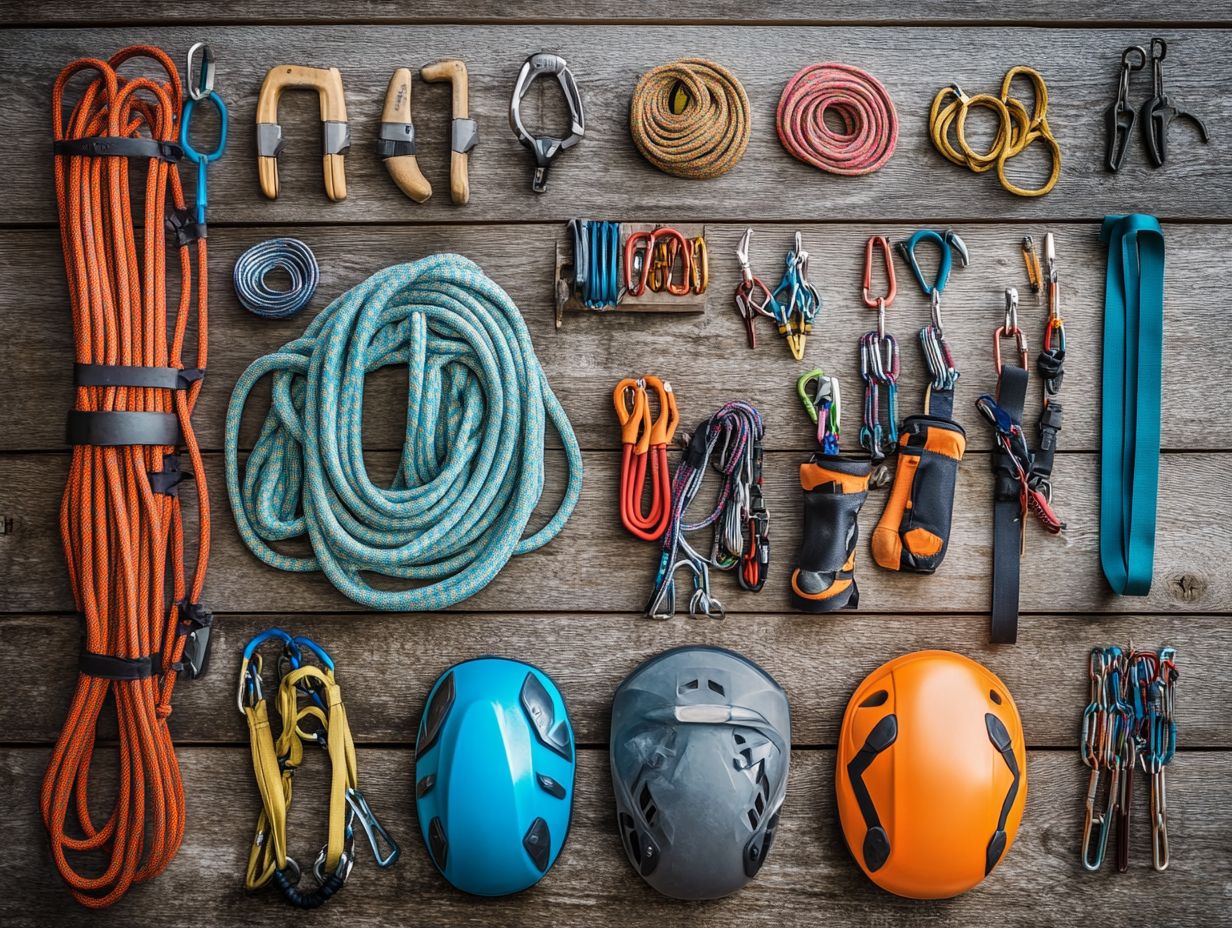
The weight of your climbing gear significantly impacts your performance and safety. Heavier gear can be harder to carry, slow you down on the climb, and increase your risk of injury due to added strain on your body.
2. What factors should I consider when looking at the weight of my climbing gear?
When evaluating gear weight, consider the specific equipment you’ll use and how it affects your overall load. Key factors include the length of your climb, the difficulty level, and the gear type you need.
3. How can I determine if a piece of gear is too heavy for me?
Listening to your body is essential. If a piece of gear feels too heavy to carry comfortably, seek a lighter alternative or consider leaving it behind.
4. Are there specific types of climbing gear that tend to be heavier than others?
Generally, traditional climbing gear like cams, nuts, and hexes are heavier than sport climbing gear such as quickdraws and bolts. However, advancements in technology have introduced lightweight options for traditional gear as well.
5. How can I reduce the weight of my climbing gear without compromising safety?
Investing in lightweight gear made from advanced materials is one way to reduce weight. Also, carefully plan and pack only essential gear for your climb, avoiding unnecessary items that add extra weight.
6. Is it worth investing in lightweight gear for climbing?
Investing in lightweight gear can enhance your climbing experience by reducing fatigue and strain. It can also make challenging routes more accessible. Just ensure that the gear meets safety standards and fits your budget.
Ready to gear up? Check out our recommended climbing equipment!

